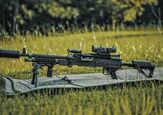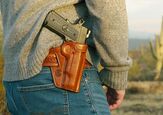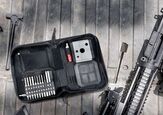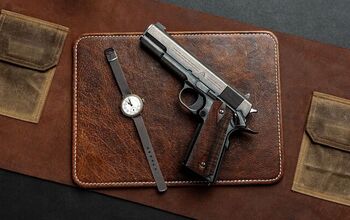Nikonov's Double XP Experimental Machine Gun

Gennady Nikolaevich Nikonov was a highly regarded weapons designer best known for his work on the short-lived AN-94 Abakan. Throughout his impressive career at the Izhevsk Machine-Building Plant, he contributed to developing several unique and innovative solutions. In 1977, he designed and completed an experimental light machine gun in 1978. This machine gun pushed the boundaries of practical application by demonstrating a fire rate that exceeded the capabilities of conventional operating systems.
The Gun
The Nikonov experimental machine gun features a large receiver designed to accommodate unconventional operating bits. The receiver has a boxy design reminiscent of the AK, with a shroud covering the two protruding barrels. For easy maintenance, it includes a removable dust cover. Additionally, the gun is equipped with a repurposed AK triangle stock, a pistol grip, a PKM rear sight, and a PKM bipod mounted on the barrel shroud.
This machine gun operates on a gas-operated system. The gas system operates each barrel separately. When one barrel is fired, it pushes that barrel forward and is synchronized by the gear assembly. This mechanism enables the two reciprocating barrels to work in unison, synchronizing their operation through a rack-and-pinion gear assembly.
The double barrel arrangement enables the system to operate using a single magazine; this approach was used to simplify the operating system since this is only a proof of concept. The synchronized double barrel system, combined with the short travel distance needed for each barrel—equivalent to the length of the cartridge—results in an extremely high fire rate. It's important to note that this is only a test bed system designed to assess the mechanical limitations. The system is chambered in 5.45x39, utilizing AK-74 compatible magazines and experimental drum magazines.
The mechanism features a mechanical connection that allows each barrel to reload the other after firing. Toothed racks are attached to the rear of the barrels, which interact with a special gear located in the receiver. This rack-and-gear arrangement is designed to synchronize the barrels' movement. A telescopic rod is connected to the synchronizing gear. When a barrel moves rearward, the telescoping rod engages the firing pin.
Unlike other automatic weapons, this experimental machine gun features a fixed bolt and does not employ a barrel-locking system. These unique design choices aim to achieve an exceptionally high rate of fire.
The Nikonov experimental machine gun does not have a traditional charging handle. Instead, to load the weapon, one of the two barrels is pushed rearward to chamber a cartridge while the second barrel moves forward. When I examined the gun, I could not remove the cover over the barrels, which prevented me from confirming the orientation of the gas system.
The trigger activates the firing mechanism, causing the firing pin to strike the cartridge in the first barrel. The expanding gases push and move the barrel forward. As the first barrel shifts, it engages with the gear rack, returning the second barrel to its rearmost position. At the same time, the spent cartridge is extracted and ejected through the designated port. Following this, a shot is fired from the second barrel.
Thoughts and Conclusion
The Nikonov machine gun is a weapon system capable of firing 1,500 rounds per barrel, resulting in a combined rate of fire of 3,000 rounds per minute. It was developed primarily to test an alternative mechanical system but will likely experience reliability issues under different environmental conditions.
The extremely high rate of fire enhances suppressive capabilities and increases hit probabilities. However, this comes with the trade-off of the rate of fire and higher ammunition consumption, increasing a logistical burden.
During one of my visits to Izhevsk at the Kalashnikov Museum, I had the opportunity to examine the Nikonov machine gun. The craftsmanship of the weapon was impressive, and the stamping quality was excellent. However, after inspecting the operating system firsthand, it would struggle in real-world trials. But this was only a proof of concept. The machine gun would have produced a powerful sound reminiscent of the roar of an M-134 Minigun. However, it would only last a fraction of a second, especially when using 30 to 45-round magazines or an experimental 100-round drum.
The development of the Nikonov machine gun and understanding of its mechanics enhanced Nikonov's engineering skills and experience, enabling him to create innovative operating systems. This expertise likely played a significant role for him during the Abakan project, ultimately leading to the brief adoption of the AN-94.
I would like to extend my gratitude for the opportunity to visit and examine the weapons at the M. T. Kalashnikov Museum.
Sources:

Lynndon Schooler is an open-source weapons intelligence professional with a background as an infantryman in the US Army. His experience includes working as a gunsmith and production manager in firearm manufacturing, as well as serving as an armorer, consultant, and instructor in nonstandard weapons. His articles have been published in Small Arms Review and the Small Arms Defence Journal. https://www.instagram.com/lynndons
More by Lynndon Schooler














![[SHOT 2025] PSA New Releases & Concept Guns](https://cdn-fastly.thefirearmblog.com/media/2025/02/01/01551/shot-2025-psa-new-releases-concept-guns.jpg?size=350x220)










![[SHOT 2025] Brownells Shows BRN-180 Gen 3](https://cdn-fastly.thefirearmblog.com/media/2025/02/01/01291/shot-2025-brownells-shows-brn-180-gen-3.jpg?size=350x220)

Comments
Join the conversation
When did you visit the museum that they let you handle a rare, experimental machine gun in person?
Cool as this is, it seems a lot more likely to energetically disassemble itself than just making a direct copy of the MG 42 in 5.45x39.